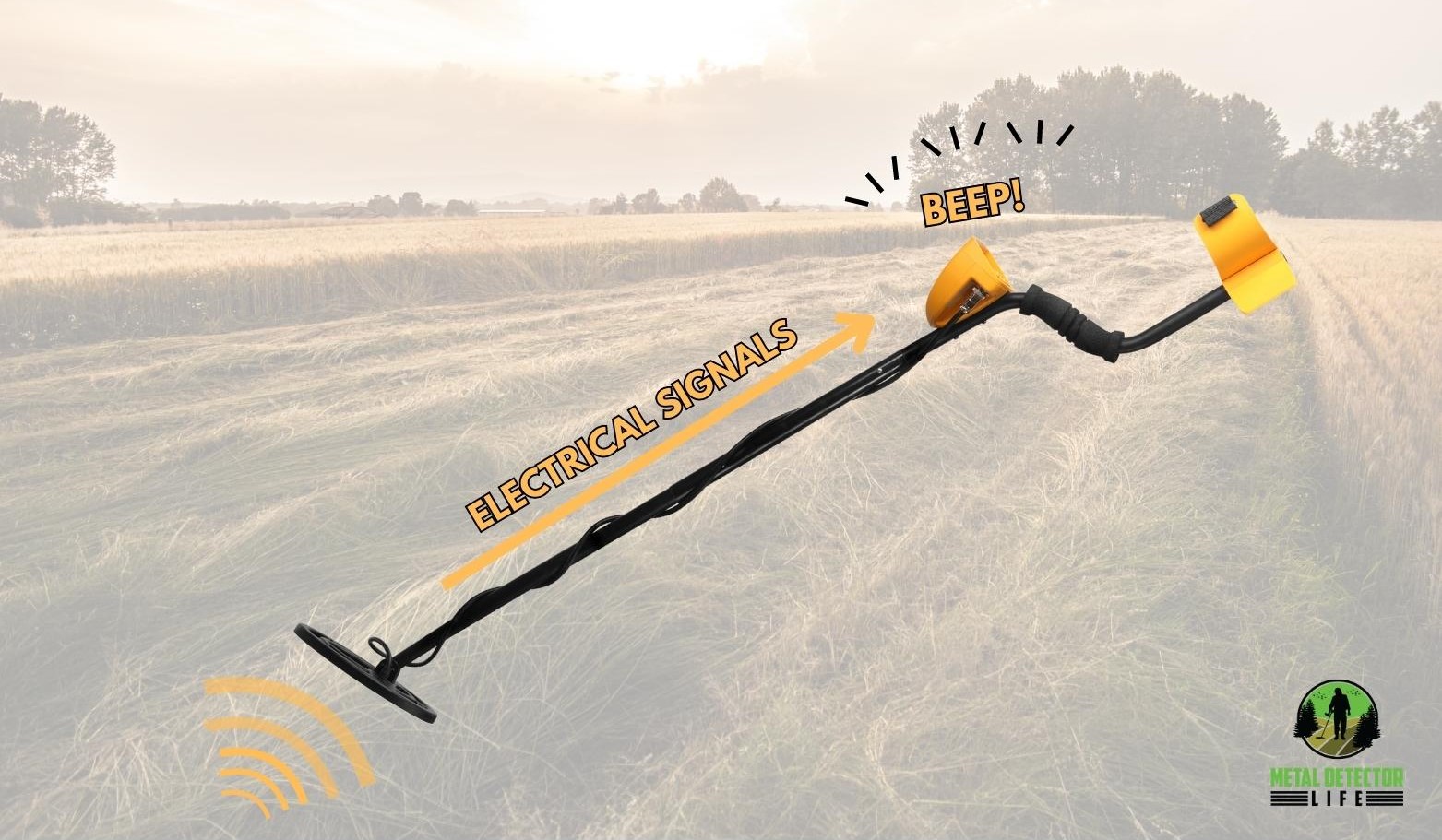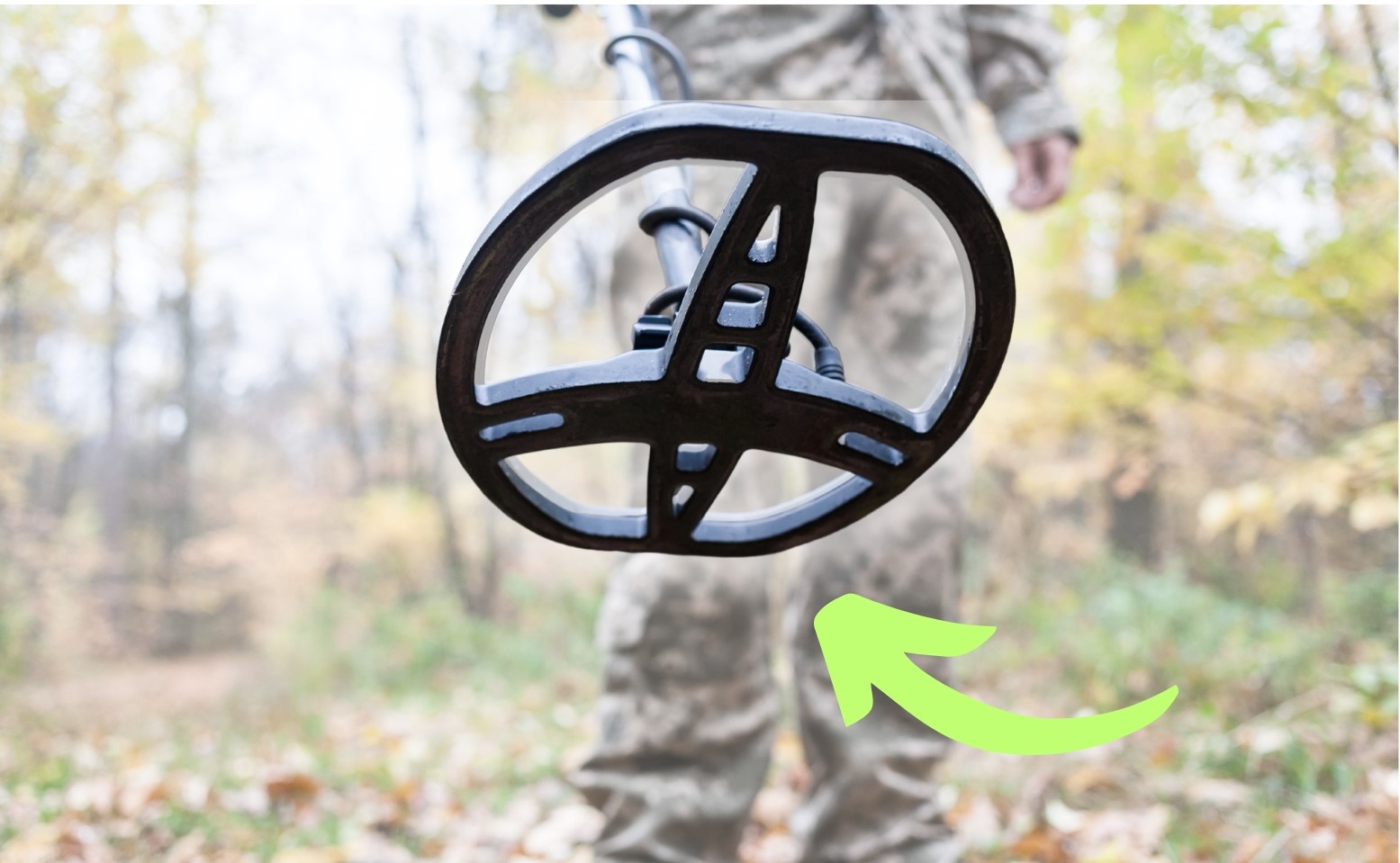It’s really fascinating how you can discover treasures like coins, thimbles, and jewelry using a hobby metal detector. The reason you can find these special objects is because the search coil of the metal detector applies a natural phenomenon.
As a result, there’s a question that metal detector enthusiasts often ask: How does the search coil of a metal detector actually work?
The search coil of a metal detector operates based on electromagnetic fields. The inner ring of the search coil, called the transmitter, generates an electromagnetic field and sends it into the ground. After this, metal objects in the ground reflect their own magnetic field. The receiver of the search coil measures the disruption in the magnetic field, causing the detector to emit a beep.
I understand that this might sound a bit vague and difficult. In this blog, I will therefore explain step by step how the search coil of a metal detector works. Enjoy reading!
Step 1: The transmitter generates an electromagnetic field
To understand how a metal detector’s search coil works, it’s important to know how the search coil is constructed.
The search coil of a metal detector consists of two rings: the transmitter and the receiver. The inner ring is the transmitter, and the outer ring is the receiver. Detecting metal objects in the ground all starts with the inner circle – the transmitter.

Inside the transmitter of the search coil, there’s a conductive wire, usually made of copper. By sending electricity from the batteries through this conductive wire, a magnetic field is created. This is called electrical induction.

This principle is also applied in transformers, generators, and electromagnets. The generated magnetic field is then sent into the ground through the inner circle (the transmitter).

Step 2: Metal objects will reflect their own magnetic field
After the magnetic field is sent into the ground by the transmitter, something remarkable happens. If there are metal objects in the ground, these metal objects will produce what’s known as “eddy currents” under the influence of the magnetic field.
Eddy currents are essentially specific currents that flow within the metal object. These eddy currents will start to flow, and during this flow, they generate their own magnetic field. This magnetic field is then sent back toward the search coil of the metal detector.

Step 3: The receiver of the search coil measures the disruption
The outer circle, the receiver, of the search coil constantly measures the outgoing and incoming magnetic field. If there’s a disturbance (due to a metal object in the ground), the receiver will generate an electrical signal and send this signal to the control box.
Inside the control box of the metal detector, all the electronics are located. When the control box receives the electrical signal from the receiver, it generates a signal itself. This causes the metal detector to beep, and that’s how the metal object is detected!

A deeper look into electromagnetic induction
So, a search coil operates based on electromagnetic induction. This is a physical phenomenon used in several devices. Therefore, I’ll provide an additional explanation about how this principle works.
Many devices, such as transformers, dynamos, and generators, contain copper wire. Passing an electric current through the copper wire generates a magnetic field.

Conversely, the same principle applies. When you pass a magnetic field through the copper wire, it generates electricity!
This produced magnetic field is then sent into the ground. After this happens, metal objects will respond by creating their own magnetic field. The metal detector detects this disturbance and starts beeping.
Do all search coils operate based on electromagnetic fields?
Yes, in principle, all metal detectors operate based on electromagnetic fields. However, besides very low-frequency metal detectors, there are also pulse induction metal detectors. The difference between these two is that a PI metal detector operates using pulses instead of a continuous alternating current magnetic field.
For the average metal detector enthusiast, a very low-frequency metal detector is the most suitable choice. Simply because these detectors are more affordable and offer better discrimination options. As a result, they are suitable for finding a wide variety of metal objects.
On the other hand, pulse induction metal detectors are often used in highly mineralized soils to primarily detect gold. These metal detectors are less sensitive to electromagnetic interference and ground mineralization.
What kind of search coils are there?
Metal detector search coils come in various shapes and sizes. The most well-known types of metal detector search coils include:
- The Double-D Coil
- The Concentric Coil
- The Monoloop Coil
- The Elliptical Search Coil
Each type of search coil has its own advantages and disadvantages. If you want to know the exact differences between each search coil, I recommend checking out my other blog.
For now, remember that large search coils can search deeper into the ground compared to small search coils. On the other hand, large search coils are less suitable for finding small metal objects compared to small search coils.
What is the best size for a metal detector search coil?
There isn’t a perfect search coil size. The right size of the search coil depends on your goal while metal detecting. If you want to find small metal objects, it’s better to use a small search coil. If you want to find larger metal objects, using a bigger search coil would be more appropriate.
However, there are many other situations to consider. For instance, detecting in mineralized soils, searching for gold, or aiming to detect as deeply as possible.
That’s why I’ve created the table below. In it, you can see the right search coil size for your specific goal!
| Goal | Recommended Coil Size in diameter (inches) | Recommended Coil Size in diameter (centimeter) |
|---|---|---|
| Finding small objects | 5-7 | 12-18 |
| Finding large objects | 10-15 | 25-40 |
| Detecting in mineralized soil | 9-12 | 22-30 |
| Detecting for gold | 8-11 | 20-30 |
| Reaching maximum detection depth | 12-18 | 30-45 |
Can you switch search coils on a metal detector?
Yes, with most modern metal detectors, you can switch search coils. Many metal detector manufacturers provide different search coils that are compatible with their detectors. Swapping search coils allows users to adapt to various search conditions and objectives without having to replace the entire detector.
For optimal performance of the metal detector, I do recommend trying to choose a search coil from the same brand as your metal detector.
Some renowned metal detector brands that offer interchangeable search coils include:
- Minelab
- Garrett
- XP Metal Detectors
- Fisher
- Nokta Makro
- Quest
How deep does the search coil detect metal objects?
The maximum detection depth of a search coil depends on multiple factors, including the size of the object, the shape of the object, the conductivity of the object, and the position of the object. However, generally speaking, a search coil can typically detect objects at a maximum depth of around 12 inches (30 centimeters).
It’s crucial to always aim to reach the maximum detection depth. A few centimeters can make all the difference between finding a treasure or not.
That’s why I’d like to direct you to my other blog about achieving maximum detection depth. After reading it, you’ll know exactly how to search as deeply as possible with your detector!
Frequently Asked Questions
Yes, the metal detector on a phone works based on electromagnetic induction. When a metal object comes into the proximity of the phone’s sensor, it disrupts the electromagnetic field, inducing a current in the sensor. The phone detects this change and alerts the user.
The type of soil and its ability to conduct electricity influence how a search coil performs. Conductive soils can create extra signals, making it challenging to identify metal objects accurately. Highly mineralized or salty soils might absorb and weaken the detector’s signals, reducing its detection depth.
Better technology helps improve search coils over time. New techniques and materials make coils more sensitive to metal and reduce interference from the ground. This means detectors can find things deeper underground and work better in different places.
Using different search coils can be really helpful. Some coils are better for finding small things, others for covering big areas fast. Changing coils can make the metal detector find things better, deeper, and notice more types of stuff, like adjusting it to work better in different places.

